Maximising Animal Performance from Mid-Season to Housing

Maximising animal performance from mid-season to housing (PDF)
Achieving the desired levels of animal performance from the mid-season period through to housing is critical on calf-to-beef systems. Target weight gains can be achieved from grass-only diets where the correct management practices are implemented.
Targets:
- Aim for a high-leaf content and good utilisation of grazing swards.
- Introduce stock to covers of 8-10cm (1,300-1,600kg DM/ha).
- Remove stock from paddocks at a grass height of 4.0-4.5cm.
- Under grazing will hit grass quality in subsequent rotations.
- Follow the ‘graze in three days, grow in three weeks’ principle (18-21 day rotation.)
- Keep topping to a minimum.
- Take excessively heavy paddocks as surplus bales if grass supplies allow.
- Use after grass – following second-cut silage – as a ‘clean break’ for stock.
- Don’t waste grass – if forced to graze heavy covers, use a strip wire.
Avoid:
- Grazing excessively-heavy covers with an abundance of stem; this will hit animal performance.
- Judging animal performance solely by appearance; use weighing data to confirm how animals are performing.
- Avoid not feeding meal prior to housing; lower dry matter grass from September on will reduce an animal’s intake capacity and performance.
- Sticking to routine housing dates; if conditions and grass availability allows, continue to graze.
- Letting animal performance slip as a result of internal parasites; higher levels of infection tend to be witnessed in the second half of the year.
Monitoring Performance
A minimum of three weight recordings should be carried out on calf-to-beef farms (turnout, mid-season and housing). Additional monitoring throughout the year is also preferred.
Benefits of Weighing:
- Provides an accurate indicator of animal performance and highlights potential failings in grassland management and dosing protocols.
- Allows informed decisions to be made around the introduction of concentrates and when to target animals for finishing.
- Aids in identifying the performance of stock from various sources – which animals performed best on my farm and are they from a particular herd?
- Arrival and weanling weights are an excellent indicator of the efficacy of the calf rearing protocol on farm.
Table 1 outlines the target weights and average daily gain targets for various steer and heifer systems. Failure to hit these targets below can result in an inability to reach the desired slaughter weights or result in delays in slaughter. The below targets for mid-February born calves are based on annual turnout and housing dates of March 1 and November 1, respectively. For calves born earlier or later in the year, the targets will have to be adjusted based on the calf’s date of birth. The average daily gain targets (ADG) outlined below represent the targeted level of performance required from one stage until the next. For example, the reared calf ADG of 0.7-0.8 represents the level of performance required until the mid-season period.
Table 1: Weight Gain Targets for Mid-February Born Calves Under Various Systems
| Calf DOB: Feb 15 |
HOFR steers (21 months) |
HOFR steers (24 months) |
HOFR steers (28 months) |
AA/HE steers (23 months) |
AA/HE heifers (20 months) |
|||||||||||||||
|---|---|---|---|---|---|---|---|---|---|---|---|---|---|---|---|---|---|---|---|---|
| Stage | Date | Weight (kg) |
ADG (kg/day) |
Weight (kg) |
ADG (kg/day) |
Weight (kg) |
ADG (kg/day) |
Weight (kg) |
ADG (kg/day) |
Weight (kg) |
ADG (kg/day) |
|||||||||
| First season targets | ||||||||||||||||||||
| Reared calf | May 15 | 90 | 0.7-0.8 | 90 | 0.7-0.8 | 90 | 0.7-0.8 | 90 | 0.8 | 85 | 0.7-0.8 | |||||||||
| Mid-season | July 1 | 126 | 0.7-0.8 | 126 | 0.7-0.8 | 126 | 0.7-0.8 | 137 | 0.8 | 120 | 0.7-0.8 | |||||||||
| Housing | Nov 1 | 220 | 0.6 | 220 | 0.6 | 220 | 0.6 | 230 | 0.6-0.7 | 210 | 0.6 | |||||||||
| Second season targets | ||||||||||||||||||||
| Turnout | March 1 | 292 | 1.0 | 292 | 0.9 | 292 | 0.9 | 310 | 0.9 | 310 | 0.9 | |||||||||
| Mid-season | July 1 | 414 | 1.0 | 402 | 0.9 | 402 | 0.9 | 402 | 0.9 | 402 | 0.9 | |||||||||
| Finish start | Sep 15 | 490 | 1.1 | – | – | – | – | – | – | 465 | 1.0 | |||||||||
| Housing | Nov 1 | – | – | 510 | 1.0 | 510 | 0.5 | 520 | 1.0 | |||||||||||
| Slaughter | Nov 15: 550 |
Carcass (kg) |
Feb 1: 620 |
Carcass (kg) |
– | Feb 1: 620 |
Carcass (kg) |
Nov 1: 525 |
Carcass (kg) |
|||||||||||
| 275 | 310-320 | 315 | 255 | |||||||||||||||||
| Third season targets | ||||||||||||||||||||
| Turnout | March 1 | – | – | – | – | 550 | 1.1 | – | – | – | – | |||||||||
| Mid-season | July 1 | – | – | – | – | 680 | Carcass (kg) |
– | – | – | – | |||||||||
| 340-350 | ||||||||||||||||||||
